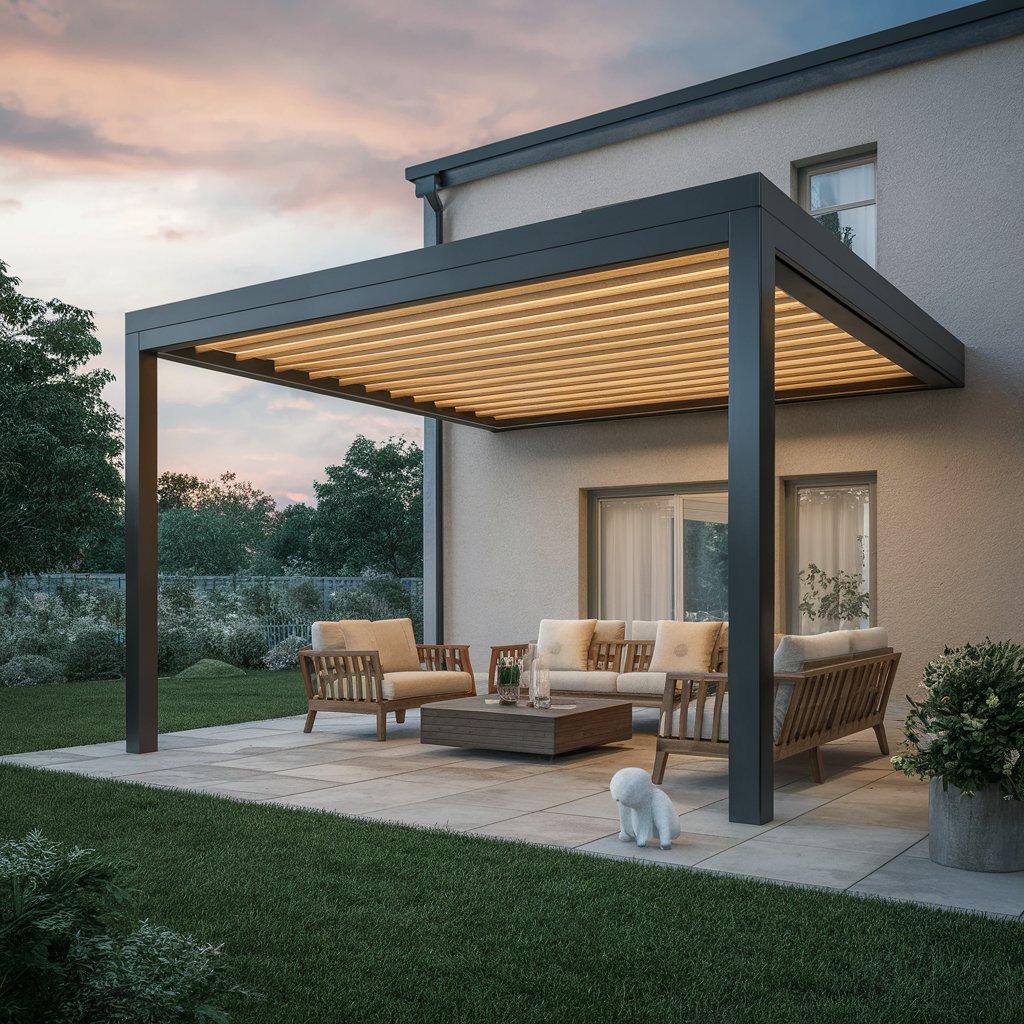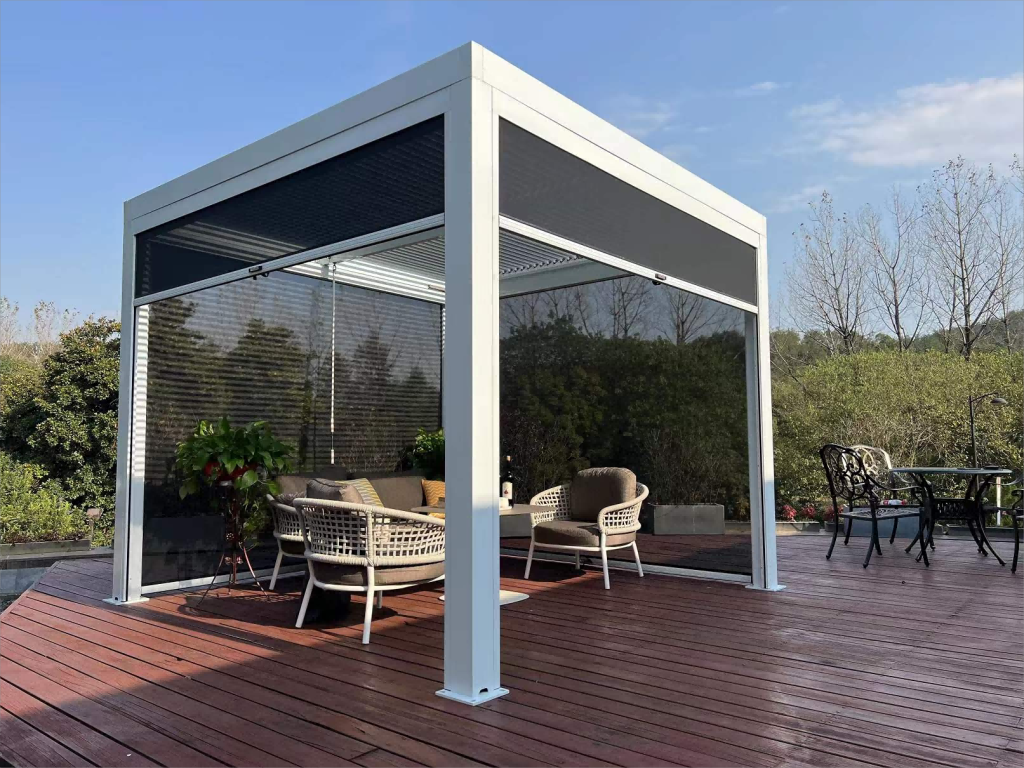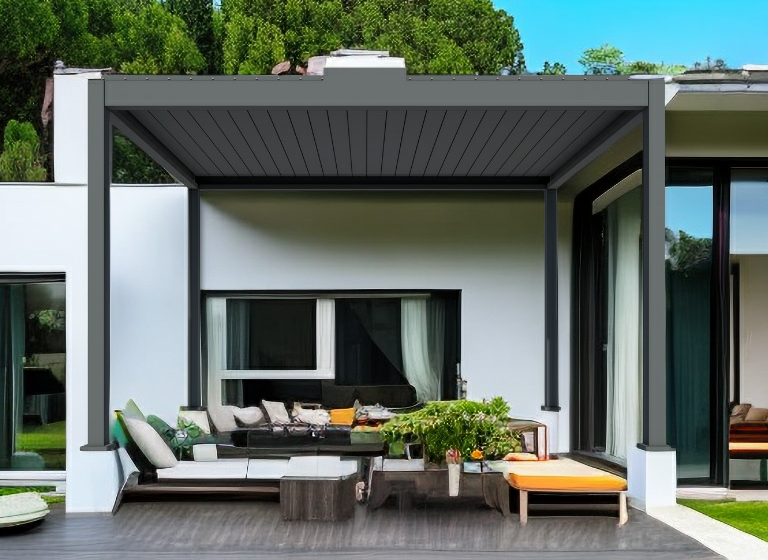Adding a pergola to your outdoor space is an excellent way to enhance your home’s aesthetic appeal and functionality. In the USA, pergolas have gained popularity for their ability to provide shade, define spaces, and create an inviting atmosphere. This comprehensive guide delves into every aspect of pergolas, including pricing, cost per foot, material options, design considerations, and the benefits of adding features such as blinds.
The Basics of Pergolas

A pergola is an outdoor structure consisting of vertical posts or pillars that support cross-beams and an open lattice. It can be freestanding or attached to a house. The primary purpose of a pergola is to provide a shaded walkway, passageway, or sitting area. Unlike a fully covered roof, a pergola offers partial shade and allows sunlight to filter through, creating a dappled effect that can be very pleasing.
Key Benefits of Pergolas:
- Aesthetic Appeal: Pergolas add a touch of elegance and sophistication to any outdoor space.
- Functionality: They provide a comfortable outdoor area that can be used for dining, lounging, or entertaining.
- Increased Property Value: A well-designed pergola can enhance the value of your home.
- Versatility: Pergolas can be customized to fit any design style and personal preference.
Types of Pergolas
Pergolas come in various styles and materials, each offering unique benefits and challenges. Understanding the types of pergolas available can help you choose the best option for your needs.
1. Traditional Wooden Pergolas: Wooden pergolas are classic and offer a natural, rustic charm that complements many home styles. Common wood choices include cedar, redwood, and pressure-treated pine.
- Cedar and Redwood: These woods are naturally resistant to decay and insects, making them durable choices. They also offer beautiful color and grain patterns.
- Pressure-Treated Pine: More affordable than cedar or redwood, pressure-treated pine is treated to resist rot and insects but may require more maintenance.
Advantages of Wooden Pergolas:
- Natural beauty and warmth
- Can be stained or painted to match your home
- Customizable in terms of size and design
Disadvantages:
- Requires regular maintenance, such as staining or sealing
- Can be susceptible to weathering and decay over time
2. Vinyl Pergolas: Vinyl pergolas are made from PVC (polyvinyl chloride) and are known for their low maintenance and durability. They are available in a variety of colors and styles.
Advantages of Vinyl Pergolas:
- Low maintenance, no need for staining or sealing
- Resistant to rot, insects, and weathering
- Easy to clean with soap and water
Disadvantages:
- Limited color options compared to wood
- May not have the same natural aesthetic appeal as wood
3. Aluminum Pergolas: Aluminum pergolas are lightweight yet durable, offering a modern and sleek appearance. They are often powder-coated to resist rust and corrosion.
Advantages of Aluminum Pergolas:
- Extremely durable and weather-resistant
- Lightweight and easy to install
- Low maintenance, does not rust or decay
Disadvantages:
- Can be more expensive than vinyl or pressure-treated wood
- Limited in terms of custom design options
4. Fiberglass Pergolas: Fiberglass is a high-end material that offers exceptional durability and flexibility in design. Fiberglass pergolas are often custom-made and can be designed to mimic the look of wood.
Advantages of Fiberglass Pergolas:
- Extremely durable and long-lasting
- Can be molded into various shapes and designs
- Resistant to rot, insects, and weathering
Disadvantages:
- Higher cost compared to other materials
- Installation can be more complex and may require professional help
Pergola Pricing in the USA
The cost of a pergola can vary widely based on several factors, including material, size, design complexity, and additional features. Here, we break down the average costs associated with different types of pergolas to help you budget your project effectively.
1. Material Costs:
- Wooden Pergolas: Wooden pergolas can range from $2,500 to $7,500 for a standard-sized pergola (10×10 feet). Premium woods like cedar and redwood will be on the higher end of this range.
- Vinyl Pergolas: The cost of vinyl pergolas ranges from $2,000 to $6,000. Vinyl is a more budget-friendly option that requires less maintenance.
- Aluminum Pergolas: Aluminum pergolas typically cost between $3,000 and $8,000. They are durable and require little maintenance.
- Fiberglass Pergolas: These are the most expensive, with costs ranging from $4,000 to $10,000 or more, depending on the design and customization.
2. Size and Design Complexity:
The size and complexity of the design are significant factors in determining the overall cost. Custom-designed pergolas with intricate details, curves, or additional features will be more expensive than standard, pre-fabricated models.
3. Labor Costs:
Labor costs for installing a pergola can vary based on your location and the complexity of the installation. On average, you can expect to pay between $500 and $1,500 for professional installation.
4. Additional Features:
Adding features such as lighting, fans, or retractable blinds can increase the cost of your pergola. Here’s a rough estimate of additional feature costs:
- Lighting: $100 to $500
- Ceiling Fans: $150 to $600
- Retractable Blinds: $500 to $2,000
Pergola Price Per Foot
When planning your pergola project, it’s helpful to understand the cost per foot. This can give you a more precise estimate and help you adjust the size of your pergola to fit your budget.
Average Pergola Cost Per Square Foot:
- Wood: $30 to $60 per square foot
- Vinyl: $20 to $40 per square foot
- Aluminum: $20 to $50 per square foot
- Fiberglass: $40 to $60 per square foot
These prices include both materials and installation. Keep in mind that custom designs or additional features can increase these estimates.
Customizing Your Pergola
Customization allows you to tailor your pergola to match your personal style and meet your specific needs. Here are some customization options to consider:
1. Size and Shape:
- Pergolas can be customized to fit any space, whether you want a small, intimate area or a large, expansive structure.
- Common shapes include square, rectangular, and circular designs.
2. Roof Style:
- Traditional pergolas have an open-roof design, but you can add a variety of roofing options for additional shade and protection from the elements.
- Options include retractable canopies, fixed shades, and lattice roofs.
3. Columns and Beams:
- The style and material of the columns and beams can significantly impact the overall look of your pergola.
- Options range from sleek, modern aluminum beams to classic, ornate wooden columns.
4. Color and Finish:
- Wood pergolas can be stained or painted to match your home’s exterior.
- Vinyl and aluminum pergolas come in a variety of pre-finished colors.
5. Additional Features:
- Blinds: Retractable blinds offer adjustable shade and privacy.
- Lighting: Incorporate LED or string lights for ambiance and functionality.
- Fans: Ceiling fans can provide a cooling breeze on hot days.
- Planters and Vines: Integrate planters or encourage climbing vines to add natural beauty.
Pergolas with Blinds
Adding blinds to your pergola can enhance its functionality and comfort. Blinds provide adjustable shade, privacy, and protection from the elements, making your outdoor space more versatile and enjoyable.
Types of Blinds:
- Manual Blinds: These are operated by hand and are typically less expensive than motorized options.
- Motorized Blinds: These can be operated with a remote control or even integrated into a smart home system for added convenience.
Benefits of Pergolas with Blinds:
- Adjustable Shade: Blinds allow you to control the amount of sunlight, providing shade when needed and letting in light when desired.
- Privacy: Blinds can create a more private outdoor space, ideal for relaxing or entertaining.
- Protection: Blinds can protect outdoor furniture from sun damage and reduce glare, making the space more comfortable.
Cost of Adding Blinds: The cost of adding blinds to your pergola can range from $500 to $2,000 or more, depending on the type and size of the blinds, as well as whether they are manual or motorized.

Installing a Pergola: DIY vs. Professional Installation
Deciding whether to install a pergola yourself or hire a professional depends on several factors, including your skill level, budget, and the complexity of the project.
DIY Installation:
- Advantages: Cost savings, sense of accomplishment, and flexibility to work at your own pace.
- Disadvantages: Requires time, tools, and expertise; potential for errors or improper installation.
Professional Installation:
- Advantages: Expertise and experience, quicker completion, and higher quality results.
- Disadvantages: Higher cost due to labor charges.
If you choose to go the DIY route, many pergola kits are available that include pre-cut materials and instructions, making the process more manageable.
Maintenance and Care
The maintenance required for your pergola depends largely on the material. Here are some general maintenance tips for different types of pergolas:
Wooden Pergolas:
- Regularly inspect for signs of rot, insects, or weather damage.
- Re-stain or seal every few years to protect the wood.
- Clean with a mild soap and water solution as needed.
Vinyl Pergolas:
- Clean with soap and water to remove dirt and debris.
- Inspect for any signs of cracking or discoloration.
- No need for staining or sealing.
Aluminum Pergolas:
- Clean with a mild detergent and water to remove dirt.
- Check for any signs of rust or corrosion and address promptly.
- Minimal maintenance required.
Fiberglass Pergolas:
- Clean with soap and water to maintain appearance.
- Inspect for any signs of damage and repair as needed.
- Very low maintenance required.
Conclusion
Pergolas are a versatile and attractive addition to any outdoor space. By understanding the various types of pergolas, their costs, customization options, and maintenance requirements, you can make an informed decision that suits your needs and budget. Whether you choose a traditional wooden pergola, a low-maintenance vinyl option, a sleek aluminum design, or a high-end fiberglass structure, a pergola can enhance your outdoor living experience.
Investing in features like retractable blinds can further increase the functionality and comfort of your pergola, providing adjustable shade, privacy, and protection. Whether you opt for a DIY installation or hire a professional, adding a pergola to your home can create a beautiful and inviting space for relaxation and entertainment.
By carefully planning and considering all aspects of your pergola project, you can enjoy the many benefits of this timeless outdoor structure for years to come.


I like this web blog it’s a master piece! Glad
I noticed this ohttps://69v.topn google.Money from blog